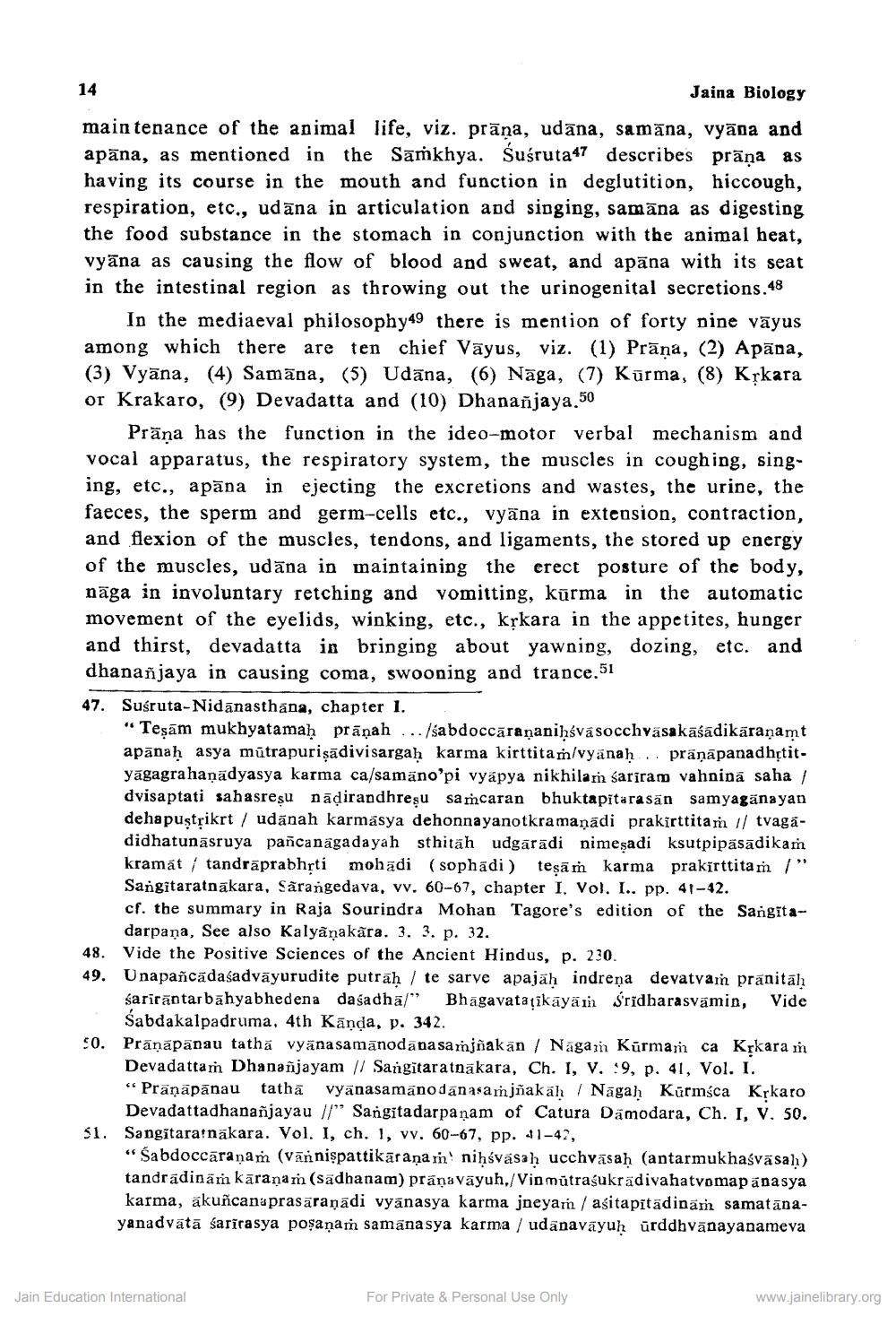________________
14
Jaina Biology
maintenance of the animal life, viz. prāna, udana, samāna, vyāna and apāna, as mentioned in the Samkhya. Susruta47 describes prāņa as having its course in the mouth and function in deglutition, hiccough, respiration, etc., udāna in articulation and singing, samāna as digesting the food substance in the stomach in conjunction with the animal heat, vyāna as causing the flow of blood and sweat, and apāna with its seat in the intestinal region as throwing out the urinogenital secretions.48
In the mediaeval philosophy49 there is mention of forty nine vāyus among which there are ten chief Vāyus, viz. (1) Prāņa, (2) Apāna, (3) Vyāna, (4) Samāna, (5) Udāna, (6) Nāga, (7) Kūrma, (8) Krkara or Krakaro, (9) Devadatta and (10) Dhananjaya.50
Prāna has the function in the ideo-motor verbal mechanism and vocal apparatus, the respiratory system, the muscles in coughing, singing, etc., apāna in ejecting the excretions and wastes, the urine, the faeces, the sperm and germ-cells etc., vyāna in extension, contraction, and flexion of the muscles, tendons, and ligaments, the stored up energy of the muscles, udana in maintaining the erect posture of the body, nāga in involuntary retching and vomitting, kūrma in the automatic movement of the eyelids, winking, etc., krkara in the appetites, hunger and thirst, devadatta in bringing about yawning, dozing, etc. and dhananjaya in causing coma, swooning and trance.51 47. Suśruta-Nidānasthana, chapter 1.
"Teşam mukhyatamaḥ prānah ... šabdoccāraṇanihsvá socchvasakāśadikāraṇamt apānah asya mūtrapurişādivisargah karma kirttitam/vyänah .. prāņāpanadhtit. yāgagrahaņādyasya karma ca/samāno'pi vyapya nikhilam sariram vahnina saha 1 dvisaptati sahasreşu nāļirandhreşu samcaran bhuktapitarasan samyagānayan dehapuştřikrt/ udānah karmasya dehonnayanotkramaņādi prakırttitam 1/ tvagadidhatunāsruya pañcanâgadayah sthitah udgārādi nimeşadi ksutpipasādikam kramát / tandraprabhști mohadi (sophādi) tesāṁ karma prakīrttitam /" Sangitaratnākara, Särangedava, vv. 60-67, chapter I. Vol. I.. pp. 41-42. cf. the summary in Raja Sourindra Mohan Tagore's edition of the Sangita
darpana, See also Kalyãnakara. 3. 3. p. 32. 48. Vide the Positive Sciences of the Ancient Hindus, p. 230. 49. Unapañcadasadvāyurudite putrāh / te sarve apajāh indreņa devatvam prānitāh
sarirāptarbāhyabhedena dasadhā/" Bhagavataţikāyam Sridharasvāmin, Vide
Sabdakalpadruma, 4th Kända, p. 342. 50. Prāṇāpānau tatha vyänasamanodanasamjnakan / Nagain Kūrmam ca Krkara i
Devadattam Dhananjayam / Sargitaratnākara, Ch. I, V. :9, p. 41, Vol. I. "Prāņāpānau tathā vānasamānodānasamjñakäh / Nāgah Kūrmśca Krkaro
Devadattadhananjayau //" Sangitadarpaņam of Catura Damodara, Ch. I, V. 50. 51. Sangitaratnākara. Vol. I, ch, I, vv. 60-67, pp. 41-42,
“Sabdoccāraṇam (Vānnispattikāraṇam nihívásah ucсhvāsaḥ (antarmukhaśvāsah) tandradinām kārana mn (sadhanam) prāņavāyuh./Vin mütragukradivahatvomapānasya karma, akuñcana prasaranadi vyānasya karma jneyarn / asitapitādinām samatānayanadvātā sarirasya poșaņām samana sya karma / udānavayuh urddhyānayanameva
Jain Education International
For Private & Personal Use Only
www.jainelibrary.org




